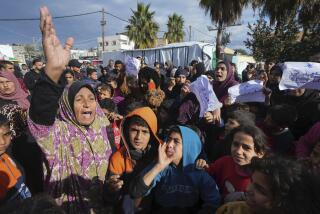Motorcycles, and life, rev up in Gaza
GAZA CITY — Defiant red graffiti on the white outdoor wall evoked the sounds of war. “The roar of the lions against the roar of the Jewish helicopters,” it said in rhyming Arabic, extolling the Hamas fighters who had stood up to Israel.
But the dominant sound Friday in Gaza City’s Asqula district was the growl of motorcycle engines, a sign that life in the Gaza Strip, battered and bloodied by a 22-day Israeli assault, is edging back to normal.
The neighborhood, home to Gaza’s weekly motorcycle market, had the look and attitude of a Harley-Davidson rally, albeit with Chinese license plates. Business was thriving.
Mohammed Ghabain, clutching a wad of Israeli shekels, was haggling over the $1,800 asking price for a cherry-red Hammer, a Chinese knockoff of the American-made original.
“Only dollars,” insisted Munadel abu Yunis, the salesman.
OK then, $1,700, countered the buyer.
With 50 or so competitors in the open-air market, the salesman relented and handed over the keys.
Gaza’s motorcycle boom is oddly linked to the conflict between Israel and Hamas, which have pledged to destroy each other. Motorcycle imports, up again since a tentative cease-fire took hold, defy a punishing Israeli-led blockade and give Hamas militants a new vehicle of choice for sneaking around.
Israel’s airstrikes and thundering ground offensive shut down the market along with so much else in this traumatized enclave, where medical officials said nearly 1,300 Palestinians were killed.
On this second Friday of the cease-fire, the two-wheel trade was part of a tableau of painstaking recovery by Gaza’s 1.5 million people and postwar posturing by their Hamas rulers.
Outdoor stands offered fresh fruit and vegetables trucked in from Israel under a slight easing of the blockade. Men arranged prayer rugs beside the ruins of bomb-damaged mosques in preparation for midday worship.
Along the Egyptian border, backhoes scraped sandy soil out of holes in the ground, reinforcing a network of tunnels that Israel bombed during the offensive but which have sprung back to life as conduits for smuggling from Egypt into Gaza.
As Ghabain and Abu Yunis were closing their motorcycle deal, a sound truck inched through the street market, summoning the faithful to a Hamas rally after the noon prayers.
There, one of Hamas’ highest-ranking officials, Khalil Haya, emerged from hiding to declare that Hamas had triumphed simply by surviving the Israeli onslaught, which was aimed at ending years of rocket fire from the Islamic movement.
He urged Hamas’ fighters, “Do not drop your weapons.”
Scattered violations have punctured the cease-fire this week, a fact that weighed on conversations in the motorcycle market.
Abu Yunis noted that a missile fired from an Israeli drone had struck a motorcycle Thursday, wounding a Hamas man targeted by Israel.
“If they call a cease-fire and those drones are still in the air, it’s not a cease-fire,” he said. “Also, the Israelis continue to bomb the tunnels. We need the tunnels for business.”
The thriving trade is a conspicuous example of blockade busting. Egypt and Israel have closed or tightly restricted Gaza’s borders since Hamas seized control of the coastal enclave in mid-2007.
Until a year ago, the only motorcycles in Gaza were Israeli models that cost as much as $3,000 each. The blockade had kept out new bikes, as well as spare parts to repair broken-down ones.
That changed abruptly last January when Hamas militants breached a border fence, enabling thousands of Gazans to flood into Egypt for a shopping spree.
Abu Yunis brought back a small fleet of motorcycles and went into business selling them. The models available in Egypt, most of them Chinese-made, can be acquired there for $600 to $1,000 each.
Alarmed by the influx of Gazans, Egyptian authorities rebuilt the fence. But they quietly allowed an expansion of the tunnel network so that cross-border trade could continue.
Like other large consumer goods, motorcycles were taken apart, smuggled under the border in pieces and reassembled in Gaza.
Hamas also used the tunnels to import components of the missiles it fired at southern Israeli communities, and that helped trigger the Israeli offensive.
But many tunnels survived the Israeli bombing and others are being rebuilt, at least for commercial smuggling. Abu Yunis said he had 15 motorcycles brought in since the cease-fire began. The one he sold Friday cost him $1,500, including a $500 tunnel fee, and brought him a $200 profit.
The trade has given Gaza militants a safer, more elusive set of wheels. When Israeli airstrikes hit targeted militants’ cars, they nearly always die in flames. But in four Israeli strikes on motorcycles this month, two of the militants survived.
Ordinary riders are alarmed by the trend. Jihad Agha, a 36-year-old teacher, said he resumed riding his motorcycle after the cease-fire was declared. But after two attacks on militant riders this week, he said, “my wife begged me to stop using it for good.”
He rides it anyway but leaves his cellphone behind, he said, believing that the Israelis use phone signals to home in on targets.
Abu Yunis has a fatalistic sales pitch to overcome reluctant buyers.
“What does it matter?” he said. “The Israelis will kill you if you’re walking down the street. Even in your home you’re not safe. So you’re going to worry about riding a motorcycle?”
--
More to Read
Sign up for Essential California
The most important California stories and recommendations in your inbox every morning.
You may occasionally receive promotional content from the Los Angeles Times.










